Lots of parrot behavior is self-explanatory – feeding, bickering, bathing, climbing, etc. But some types of body language require more insight if you are to fully understand what your parrot is communicating.
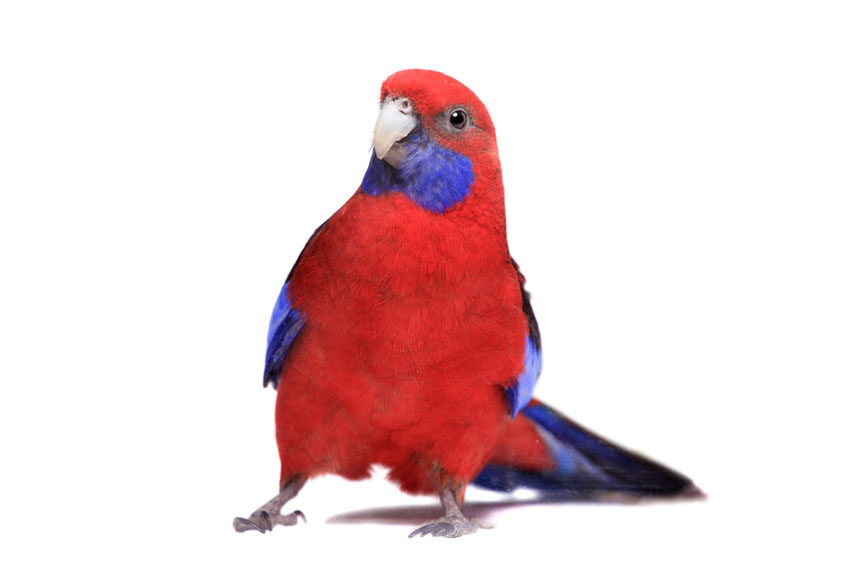
This Crimson rosella is trying to tell you something!
Beaks
- Grinding and Clicking – see the Parrot Sounds section.
- Jousting – birds that spar with their beaks in a parrot-wrestling match are just having fun, and are the best of friends. Real anger involves a lot of flapping and squawking.
- Wiping – Parrots wipe their beaks after eating, especially if they’ve been snacking on something wet or messy (banana, for example). Some parrots wipe their wet beaks to mark their territory.
Biting
Something to discourage, this is a sign of naked aggression, over-defensiveness, and/or fear. You usually get a bit of warning before an attempted bite – the bird crouches and opens its beak prior to the attack. Its pupils will usually dilate too. If the biting is aimed at you, getting the parrot used to your presence (and humans in general) will defuse the problem over time. If the parrots are biting each other in an aviary, it will usually be an overcrowding problem. Sometimes a persistent biter has to be isolated from other birds until it shows signs of playing nice!
Chewing
Parrots love to chew. To fulfil this natural instinct they should be supplied with chewing toys made from non-toxic materials such as wood or egg boxes.
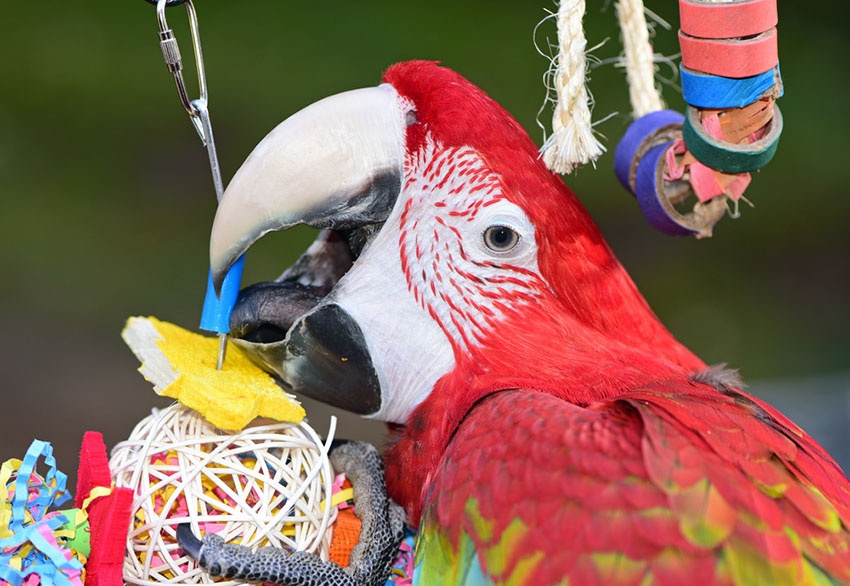
Chewing it over - Scarlet Macaws love lots of beak exercise
Crests
Cockatiels and Cockatoos use their feather crests to express themselves. When relaxed and happy, the crest will be flat or just slightly raised. A raised crest means excitement of some kind. Usually, this is a sign that the bird is really pleased to see you (or the food in your hand!). This is not to be confused with an erect crest that stays in that position. This is a sign of fear, anger or over-stimulation of some kind. A cockatoo in this mood is likely to bite.
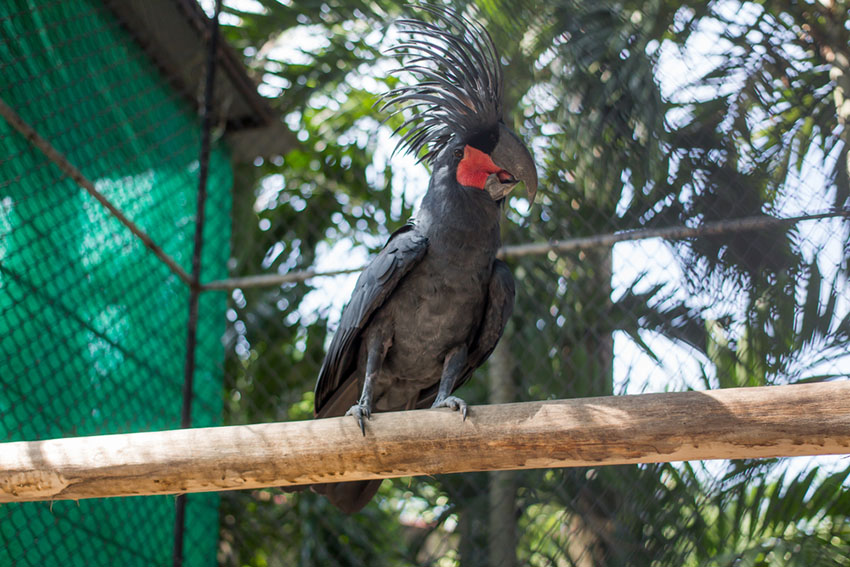
This Palm cockatoo is in a state of excitement, indicated by the erect crest
Feathers, Ruffled
Parrots, like most birds, ruffle their feathers as part of preening and grooming. This shakes out any dust and dirt and enables the parrots to reach the roots of the feathers where dirt accumulates. It also acts like the shaking of a quilt, allowing the feathers to settle back neatly into their correct positions. Sometimes a parrot will give a little shivering ruffle, which helps them relieve tension. If the feathers are fluffed-up all the time and the bird is hunkered down, the parrot is either cold or ill. Any doubts about a parrot’s health should be put to a vet.
Hanging Upside Down
This is a sign of a very happy bird. Not all parrots do it, but many do, and they clearly enjoy the sensation. So it’s nothing to worry about!
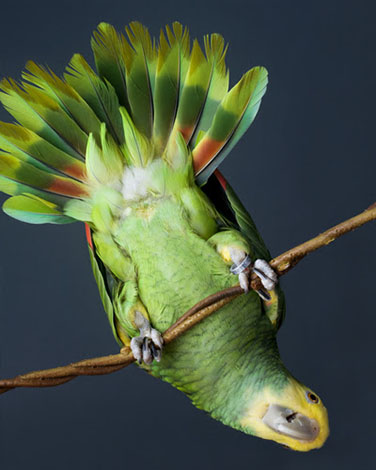
Upside down Double Yellow-Headed Amazon!
Heads
- Head-bobbing means the parrots wants your attention. The movement is also part of the courtship ritual in many species. Single birds will often adopt head-bobbing habits, bobbing to mirrors or toys in their cage.
- Head-shaking appears to be simply a parrot habit, and fulfils no obvious purpose. It is particularly common in African Greys. It’s nothing to worry about, but it’s a good idea to make sure your bird is stimulated and isn’t shaking its head through boredom. Replacing cage toys or spending more time with the bird will do the trick.
Legs and Feet
- Raised – a raised leg with claw clenched into a ‘fist’ is simply how parrots rest. They do it to preserve body heat, but some just enjoy perching on one leg no matter what the temperature is. Many parrots perch on one leg while feeding with the other foot.
- Tapping – this is something mostly associated with Cockatoos, although other species sometimes get the habit too. Foot tapping on a perch usually means “This is my territory”.
- Collapsing – Parrots sometimes do this when being handled. They squat down, usually as a sign that the bird doesn’t want to do whatever you’re about to make it do – often to avoid returning to the cage after some fun-time outside. Being clever, the parrots learn that ‘collapsing’ like this brings a few more minutes extra attention, and so they turn it into a habit. When you return the bird to its cage or perch, the legs ‘magically’ work again!
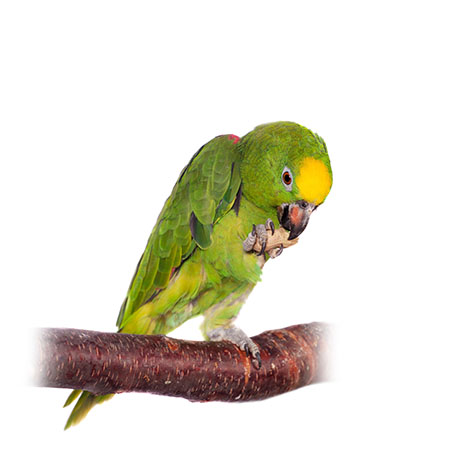
Yellow-Crowned Amazon using a foot as a ‘hand’
Regurgitating
The saying “sick as a parrot” reflects the fact that these birds like to regurgitate! What this means is that they eject pre-swallowed food that has been stored in their crop. Regurgitation is how parrots feed their young, and the male feeds his nesting partner in this manner too as part of the bonding process. If your pet starts to offer you regurgitated seeds, with pupils dilated (known as eye-pinning), head-bobbing, and neck-stretching, it is a sign of deep affection. However, it’s not one you want to encourage. If your bird starts doing this to you, don’t encourage it. Don’t speak or give it any extra attention, and it should soon get the message that this throwing-up type of affection doesn’t work its magic on humans!
Scratching
Parrots scratch their head and neck as part of preening and grooming, tackling places the beak alone cannot reach. A parrot that scratches the cage bottom with its claws is foraging - just like a chicken. Not all species do this, but the African Greys spend a lot of time in ‘chicken mode’.
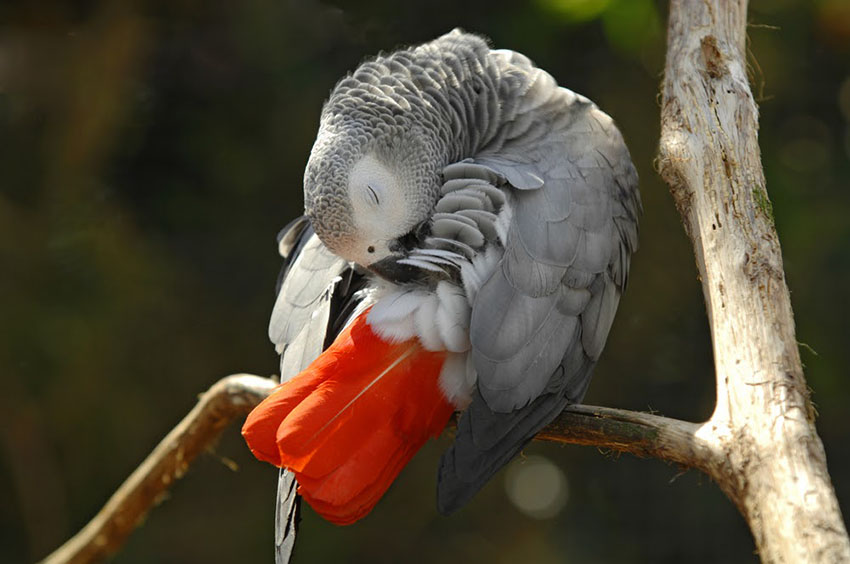
Chicken in a previous life? African Greys often likes to scratch the ground for food
Tail
- Tail-wagging (side to side) – this means the parrot is happy to see you (or who/whatever else the tail is being wagged at); or it means the bird is going to poop. If you are trying to house-train your parrot, this is a key sign to look out for (see the Toilet Training a Parrot section of this guide).
- Tail-flipping (moving it rapidly up and down) is a sign of a contented bird: the parrot is pleased to see you, or is enjoying a game, or a favorite snack.
- Tail-bobbing – if the tail moves gently up and down accompanied by panting, the parrot is just catching breath after exercise. If no exercise has taken place, it’s a probable sign of illness and needs the attentions of a vet.
- Tail-fanning – Not all parrots can fan their tails. It’s generally a display of aggression or anger. In the wild it’s a territorial show of dominance, often linked to the breeding season.

Blue and Yellow macaws – it’s all in the body language
- Drooping – wing-drooping means the bird is exhausted, overheated or ill. A parrot fresh from the bath, however, is simply speeding up the drying process by drooping the wings. Young parrots droop their wings too.
- Flapping – Flapping the wings, without attempting to fly, means one of three things. It could be a simple stretching exercise; your parrot may be seeking attention; or it just be flapping out of contentment.
- Lifting – The wings are often lifted when the parrot wants to cool down, or simply stretch.
- Ruffling – After flight, a bird shakes its wings to get everything back in the right position. But the wings may also be ruffled if the parrot is agitated or in pain. If your pet hunches it shoulders and bobs its head at the same time, it is desperately looking for attention (often because the food tray is empty!) Birds perform this hunched, head-bobbing, wing-shaking dance in the mating season too.
Clipping Parrot Wings
Wing-clipping is not universally carried out on pet parrots, but many parrot keepers recommend it. The purpose is not to prevent flight, but to slow it down. If correctly clipped, the parrot will be able to fly, but will not have much ‘lift’. In confrontational situations, this will (for example) prevent an angry male from pursuing and injuring an unwilling female. It also makes recapturing escaped birds a bit easier.
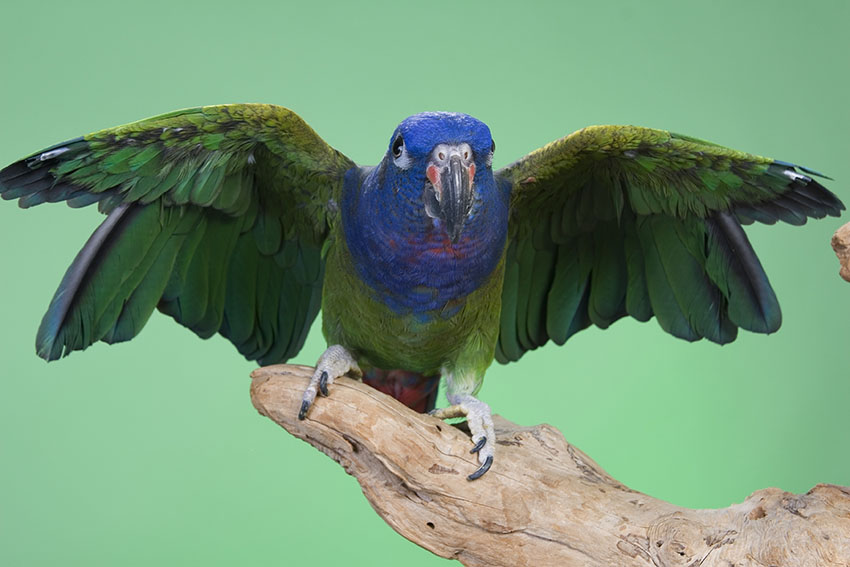
This Blue-Headed Parrot has had its primary wing feathers clipped
The clipping must be performed by someone who knows what they’re doing. Poorly clipped wings can make the parrot lose balance, or may lead to bleeding or injury. Badly clipped feathers can irritate parrots, and the bird may self-peck or pluck itself as a result.
Wings should never be clipped before the parrot has learned how to fly, otherwise the bird will never master the subtle balance needed for take-off and landing.
Comments
Ronald, 3 March 2024
Stopping my African Grey's habit of pecking on the bottom of the cage?
Ronald, 3 March 2024
I have a 15yr. old African Grey who's getting a habit of pecking on the bottom of its cage and won't stop until I open the door and run him up to the perches. What suggestions do you have to correct this habit?
Bob, 25 February 2024
My conure is clinging to his for two weeks What’s wrong?
Frank, 11 December 2023
My blue gold macaw who is 21 years old will not stop feeding his toys and becomes very aggressive if I try to remove them. Also, he does not relieve himself in the cage. He holds it in all night until I put him on his perch in the morning. Should I be concerned?
Clara, 6 January 2023
My blue fronted Amazon 1 year and 7 months old parrot frequently goes thru the motions of swallowing with his mouth open. Can this mean he is having swallowing issues, he usually does it after he eats his dry food.